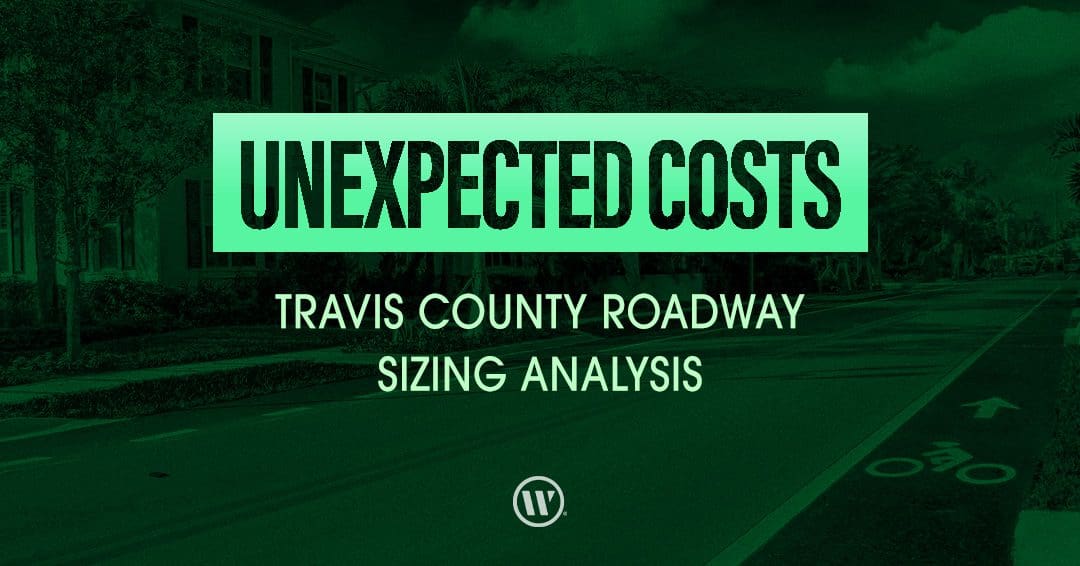
TxDOT Driveway Spacing
If you are developing a property on a roadway that is controlled by the Texas Department of Transportation (TxDOT), you will have to consider TxDOT standards on driveway spacing. WGI can help.
Learn from award-winning professionals — explore our whitepapers, blogs, and the latest industry updates.
Join our dynamic organization of engineers, land surveyors, landscape architects, environmental scientists, and architects!
Talk to a market leader today! We’ll answer any questions you have about our professional services.

If your development will generate more than 1,000 net new vehicle trips per day, you will be required to complete a Traffic Impact Analysis (TIA) in Travis County. One of the most significant components of the Travis County TIA is the Road Sizing Analysis for boundary streets, but this piece of the process can catch developers off guard financially if they’re not planning for it. Here’s what the code says and how it applies to you.
What does Travis County’s code say?
Section 482.202 of the Travis County Development Regulations Code requires any street that borders a proposed subdivision and will be used for access to be improved to at least minimum County standards. If improvements are necessary, sufficient right-of-way must be dedicated along the site frontage, and fiscal for the half of the roadway widening that abuts the development must be contributed to the overall cost of mitigations and improvements in the TIA.
When is a street “substandard?”
“Minimum County standards” are based on several factors including the roadway’s functional classification (e.g., local street, residential collector street, minor arterial street, etc.), the predicted average daily traffic by the development’s buildout year, and the roadway’s speed. Travis County uses the cross sections provided in the City of Austin’s Transportation Criteria Manual (TCM) to define the appropriate cross sections for boundary streets with these specific characteristics.
If, for example, a roadway with the volume and speed characteristics of a residential collector street has only 30 feet of pavement, no curbs or sidewalk, and 50 feet of right-of-way, the roadway is substandard and must be upgraded to provide 37 feet of pavement, curb and gutter, sidewalks, and ten additional feet of right-of-way in accordance with the TCM’s minimum requirements.
So, what am I responsible for?
The extent of the developer’s responsibility to improve a substandard street is determined by Travis County on a case-by-case basis. After all mitigations and improvements are proposed and the developer’s pro-rata share of the overall cost is determined as part of the TIA, Travis County can decide which mitigations and improvements will be constructed from the funds owed to the County and which will be part of a donation agreement.
Travis County may require the developer to widen the roadway if the total cost of the substandard street improvements is less than the developer’s pro-rata share and if it is in the best interest of the development and the local roadway network. If the roadway widening is not an immediate priority for the County, the developer will be responsible for dedicating the appropriate right-of-way along the site frontage and paying a “fee-in-lieu” that covers only the fraction of the widening and construction costs proportional to the development’s traffic impacts.
Learn More
Do you have questions about Travis County’s Road Sizing Analysis and what you should expect before starting your next project? We can help! Contact us today to speak with one of our experts.

WGI is a national design and professional services firm leading in technology-based solutions for the construction of public infrastructure and real estate development. At WGI, we’re providing Tomorrow’s Infrastructure Solutions Today.

If you are developing a property on a roadway that is controlled by the Texas Department of Transportation (TxDOT), you will have to consider TxDOT standards on driveway spacing. WGI can help.

WGI has been in overdrive for the first three quarters of 2019, exceeding 2018 in the expansion of its employees, services, clients, and geographic footprint.

Gain valuable insight into the complexities of Street Impact Fees (SIF) for single-family, multi-family, and commercial uses directly from WGI’s industry-leading experts.

Webinar series recap! Bob Clemens and Wes Kaisershot presented an in-depth history and overview of the SUE practice. Participants also learned how SUE is instrumental in saving time and money on infrastructure and building projects.

Covering approximately 115 acres, Northline is anticipated to include a mix of complementary uses, including retail, office, residential, hotel, and parks.

TxDOT no longer accepts paper, or PDF, utility permit forms. Luckily, WGI has you covered. Here are some tips and trick for using the UIR system.
You’ve been searching for a place like WGI. We look forward to meeting you soon.
Sign up to receive emails to hear our latest news and achievements in our monthly newsletter.
Enter your zip code, and we’ll personalize your experience with local projects, office locations, team members, and more.
WGI supports its associates with meaningful opportunities for growth, strong benefits and perks, while we work collaboratively with clients and co-consultants to shape and improve communities.






WGI is a dynamic organization with opportunities nationwide for engineers, land surveyors, landscape architects, environmental scientists, and architects.